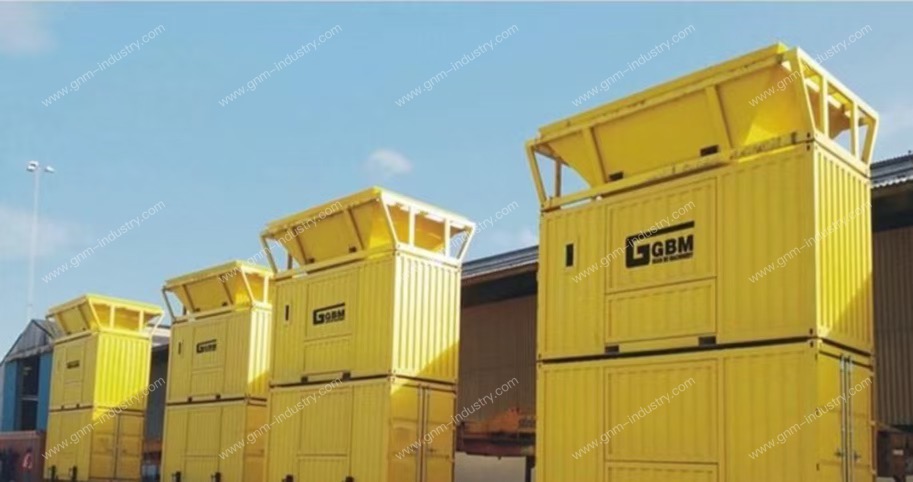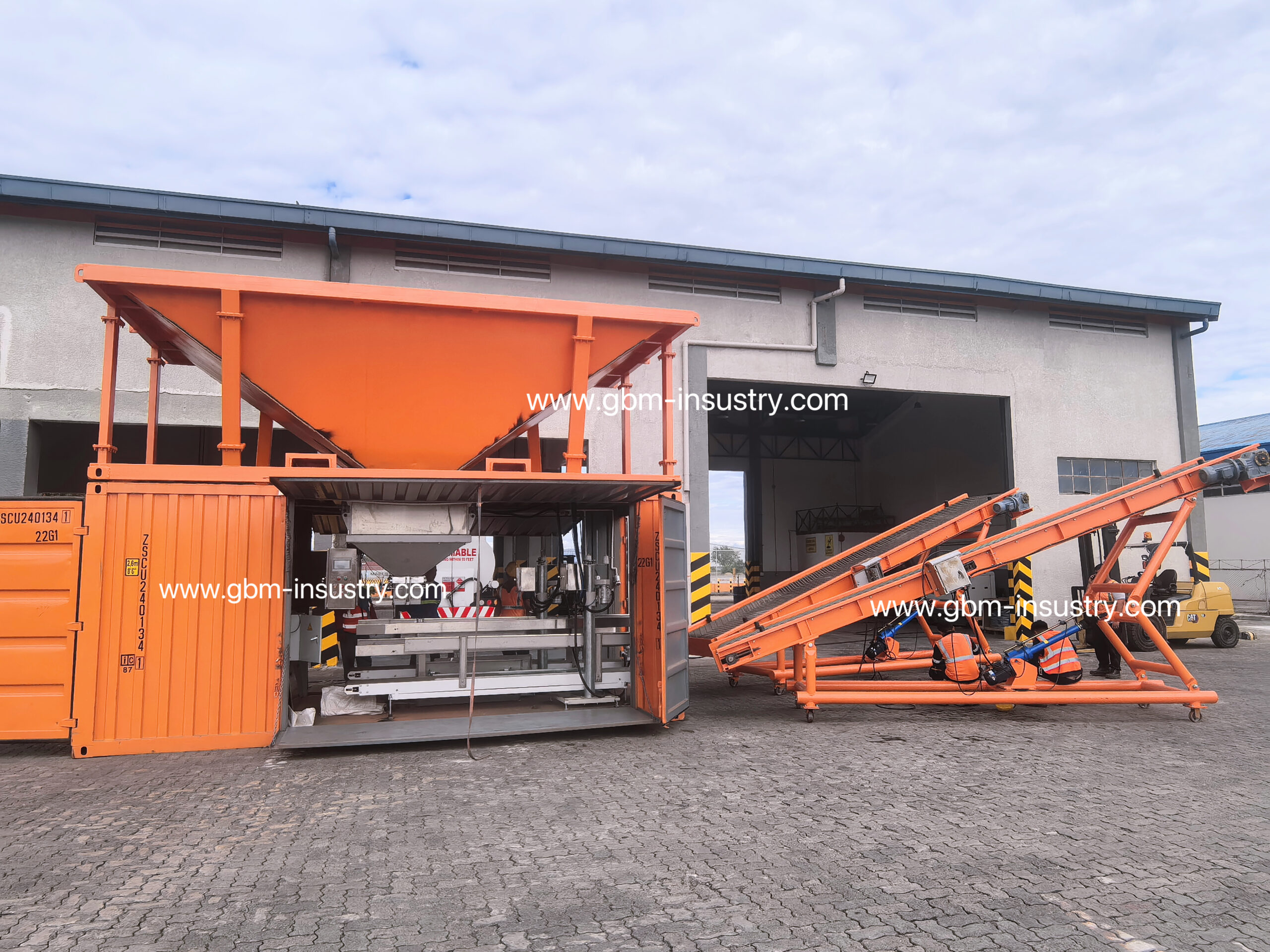Troubleshooting Weighing Errors Guidance In Bulk Cargo Bagging Machines
Agricultural industry is a major industry for every country, and every year there is a huge demand for potash fertilizers for agricultural cultivation. Therefore, large quantities of potash fertilizers need to be imported from abroad every year. As a result, the loading and unloading of bulk chemical fertilizers accounts for a certain proportion at various ports. In the face of competition from surrounding ports, only by maximizing service quality can it gain the upper hand in the current fierce port competition. In terms of bulk bag filling, improving service quality means ensuring weighing accuracy, which is also a way to improve work efficiency.
Bagging process introduction
The GBM GBCC bagging machine currently in production can weigh and bag all kinds of granular bulk materials.
The weighing process of the bagging machine: the material is crushed by the crusher and then falls under its own weight into the feeder. After coarse and fine feeding, the feeding action is completed when the weight reaches the set standard value in the system (e.g. 50kg). When the gate is closed after the fine feeding is complete, there is still a small amount of material in the air that has not completely fallen into the weighing hopper because the feeder is a distance away from the weighing hopper. In order not to affect weighing accuracy, this part of the material can be compensated for by setting the “flying material value” (cps parameter) in the system. When the flashing material falls into the weighing hopper, the weighing process ends, and the PLC control system will issue a discharge command to open the weighing hopper gate. The material will fall into the fertilizer bag previously clamped by the worker through the discharge chute, completing the entire weighing and packaging process.
Analyzing error phenomenafor normal bagging machine
During the entire weighing and packaging process, if the weight of the material in the weighing hopper does not meet the preset value, the system will issue an error indication, and the error indicator light on the PLC control container will turn on. At this time, the worker needs to manually operate the unloading and adjustment to unload the material into the chute, which will greatly affect the entire weighing and packaging process. In order to improve the efficiency of weighing and packaging, the question of how to quickly and accurately determine the cause of weighing errors is what this article will discuss.
2.1 Various weighing error phenomena
GBM has been engaged in bulk chemical packaging operations for several years and has found that the main factors affecting the accuracy of bulk chemical weighing are materials, operating environment and electrical components. The phenomena manifested by weighing errors mainly include the following:
(1) Errors occur at intervals, and the error values are large, generally above 1kg;
(2) Errors occur frequently, and the error values are fixed;
(3) The error range is large, but the over-range indicator does not light up, and the packaging action can proceed normally;
4) The error range is large, and the weighing speed slows down;
5) The error occurs frequently, sometimes exceeding or falling short of the tolerance, and the error value is small.
Analyze the cause of the error
The following is an analysis of each of the above error phenomena:
3.1 Error caused by uneven material falling.
This situation is generally caused by uneven material falling. A typical cause is material caking
Due to long-term sea voyages and severe moisture in the cabin, fertilizer often clumps after arriving at the shore. Although the material is crushed by the crusher before falling into the bagging machine, there is also the phenomenon that the crushing screen is damaged and the material is not completely crushed. Therefore, at this time, you should first check whether the crushing screen is intact and whether the spacing of the mesh bars meets the requirements for crushing the material. If the material enters the weighing hopper in lumps, its density will be very different from that of powdered materials, so even if the other parts are accurate, the system’s final judgment on the flashing material value will be wrong.
3.2 Error caused by error in the calibration.
This type of error mainly occurs because there is an error in the original empty weighing calibration and the actual weighing calibration, resulting in the same error in a series of subsequent weighings. When the original tare calibration is inaccurate, it causes the system to overestimate the original weight value in the tare state, and when the actual weight is weighed, more weight will be “converted”, resulting in an error between the displayed total weight and the actual weight of the material. At this time, the zero value should be reset, and the tare calibration and actual weight calibration should be performed again.
3.3 Error caused by sensor installation or sensor performance
This phenomenon is more complicated, mainly due to problems with the performance or installation of the sensor
We use three strain gauge load cells to weigh the entire filling process. When one of them ages, its measurement function will produce errors. When there is a problem with the sensor, in addition to testing each sensor individually, you can also take a 5kg weight and suspend it near the point where the three sensors are located (near the sensor boom). Generally speaking, the weight of the normally working sensors at this point is close, and the error will not exceed 0.5kg. If the weight displayed by the sensor at any point is significantly different from the other two points, then basically you can determine that this sensor is faulty.
In addition, contact between the sensor’s peripheral components and the hardware may also cause this error. Our company has also encountered a relatively special example: the displayed weight is correct, but after placing the package on the scale and weighing it again, it is always found to be less by a few tenths of a kilogram. After checking the sensor readings, it is found that the balance rods of the hanging rod and weighing pan are in order. Finally, after carefully inspecting the sensor mounting base, it is discovered that the positioning of the limit screw on the sensor base is too high, blocking the bottom of the sensor, reducing the downward bending of the sensor and thus affecting the correct reading. Although the sensor is in good working order, there will be an error in the actual weight.
3.4 Error caused by the mechanical component’s failure.
The seal ring of the cylinder that drives the weighing parts will wear out after long-term use, causing air leakage and insufficient driving pressure. This will also reduce the action rate, affecting the closing speed of the weighing hopper and subsequently affecting the weighing of the material. The solution is to replace the cylinder. Generally speaking, it is best to conduct a comprehensive inspection and maintenance of the pneumatic components in the bagging machine after 100,000 to 150,000 tons of unloading operations to ensure that they can work normally. In addition, air leaks from the cylinder will also increase the workload of the air compressor, and this should be minimized.
3.5 Error caused by weather and environment conditions.
This phenomenon is mainly caused by weather conditions or the operating environment
The port area is close to the sea, and the moisture is heavy, causing the fertilizer to absorb water and become viscous, especially when loading and unloading materials that are prone to absorb water and pulverize, such as compound fertilizers and heavy calcium. The pulverized material will adhere to the weighing hopper and around the gate, causing frequent errors and relatively fixed values. In this case, workers need to be diligent in cleaning the weighing hopper and gate, and keep the measuring chamber of the bagging machine tidy. If the situation is more serious, a clean fertilizer bag can be placed next to the gate to prevent the material from contacting the gate, which is contaminated with moisture, and reduce the chance of the material adsorbing.
Why choose GBM Mobile bagging machine
In bulk chemical loading and unloading production, maintaining the weighing stability and accuracy of the bagging machine is of great significance for bulk chemical operations. By reducing weighing errors and improving weighing quality, the burden on bagging workers can be reduced and bagging efficiency can be improved, which is especially true for loading and unloading operations where time is money.
GBM adopt Quick coarse feeding and small flow fine feeding combined for accurate weighing
Material weighing process: When the equipment control system receives the signal to start working, the coarse and fine feeding solenoid valve is energized, the feeding gate is fully opened, and the material quickly falls into the weighing hopper, commonly known as coarse feeding;
When the material reaches a certain weight, the coarse feeding solenoid valve is de-energized, the feeding gate is closed, and the fine feeding process begins. The material falls into the weighing hopper with a small flow until it reaches the target weight value, the fine feeding solenoid valve is de-energized, the feeding gate is completely closed, and the whole weighing process is over.
GBM bagging machine with best technology for least problem and most importantly, with least weighing error.
GBM provide good services and innovative technology to clients all around world, with best quality products. Welcome to visit us factory and consult for more details;





